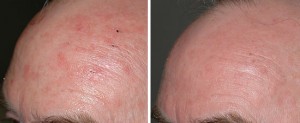What is PDT?
Photodynamic (PDT) skin rejuvenation utilizes a medication called Levulan (20% aminolevulinic acid) and specific wavelengths of light that photoactivate the medication.
Levulan comes as a clear liquid that is painted on the face and allowed to “incubate” for a set time. The light then activates the aminolevulinic acid which is converted into oxygen radicals which then diminish or eliminate precancerous facial lesions (AK’s).
We are also using PDT to treat acne with great success. PDT can be combined with intense pulsed light (IPL) therapy to achieve an even better result particularly if brown pigment and small capillaries and redness are a concern. Additionally PDT treatment provides a form of skin rejuvenation that gives an overall benefit to the skin in terms of skin texture and fine lines.
What are AK’s and how are they treated?
 A.K. or actinic keratosis, are potentially pre-cancerous lesions on the face that appear as discolored or crusting lesions that will not heal. They are usually the result of many years of sun damage to the skin. Individuals with fair skin are more susceptible to AK’s. Approximately 20% of AK’s will become cancerous over time. Not all AK’s are clearly visible on the skin.
A.K. or actinic keratosis, are potentially pre-cancerous lesions on the face that appear as discolored or crusting lesions that will not heal. They are usually the result of many years of sun damage to the skin. Individuals with fair skin are more susceptible to AK’s. Approximately 20% of AK’s will become cancerous over time. Not all AK’s are clearly visible on the skin.
Typical areas for them to appear are on the face, ears, neck, hands, and arms but they can occur on virtually any sun exposed area of the body.
How are AK’s treated?
The traditional treatments for AK’s include spot treating with liquid nitrogen or application of one of several topical agents such as 5 Fluorouracil (Efudex) or Imiquimod (Aldara) creams. These agents work by causing necrosis (cell death) of the tissues onto which they are applied. All are effective but all have potential problems.
Why PDT?
Liquid nitrogen is still considered the “gold standard” treatment of AK’s since it is fast, cheap and usually effective. Liquid nitrogen can, however, leave hypopigmented (white) spots where applied since it can also kill the melanocytes (pigment dells) as well as the AK’s. Liquid nitrogen is not practical for treating a larger surface area and the blistering and scabbing associated with treatment may not be tolerated by some patients. Topical creams such as Efudex or Aldara require application for 3-4 weeks and induce considerable redness and irritation where applied. Many patients cannot tolerate these creams.
They also have potentially severe systemic toxicities.
Photodynamic therapy is a viable alternative for these reasons:
-
Seen and unseen
Can treat the entire face in one sitting thereby eliminating AK’s that are both seen and unseen
-
well tolerated
Is associated with only a few days of redness that is well tolerated
-
No scarring
Does not cause hypopigmentation or scarring
-
Reduces…
Reduces surface irregularities, sebaceous hyperplasia (enlarged oil glands) and acne lesions on the skin
-
overall cosmetic benefit
Provides an overall cosmetic benefit to the skin like a chemical peel
-
Photodynamic
Photodynamic therapy illustration